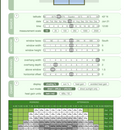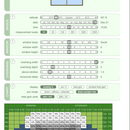Overhang / Window Placement / Sun Exposure modeling
I am looking for a process/math check on the dimensions needed to sort out window placement on a south side wall.
Background:
- House is a rectangle with 9/12 pitch roof
- 18” raised heel truss
- 8’ walls (on south side)
- Long wall to face due south
- Using https://www.susdesign.com/overhang/index.php to get a sense of summer shading / winter sunning at my latitude (43 degrees)
To use the above mentioned tool, I need to know the height above the window, overhang length.
I have a couple diagrams where I’ve drawn out my thinking.
Drawing #1 shows my understanding of the ‘overhang’ – horizontal dimension from the edge of the eave to the wall.
Drawing #2 shows solving for the location on the wall where the overhang will be.
In this case, the overhang will be (coincidentally) at the top of the 8’ wall, since I am using an 18” raised heel truss,
So, it appears to me that using a 5’ x 5’ window placed in the center of the wall (18” from the top of the wall), I can get good shading in June at noon and full sun in December at noon.
Does this look right?
GBA Detail Library
A collection of one thousand construction details organized by climate and house part












Replies
The two other dates you need to take into consideration are March 21st and Sept 21st. These dates fall halfway between the summer and winter equinoxes so the sun is halfway between the highest and lowest points in the sky. An overhang that blocks all sunlight from hitting a window on June 21st may let in too much heat and glare on Sept 21st and cause over-heating so that date is more important than the March 21st one.
Thanks - I'll check out those days as well.
The problem you run into is that temperature lags sunshine by about five weeks, in most of North America the hottest day of the summer is around August 1 and the coldest day of the winter is around February 1. So while June 21 has the most sun, it's about the same temperature as September 10, and December 21 is about the same temperature as March 10. On the equinoxes, March 21 is about the same as December 10 and September 21 is about the same as June 10.
So there isn't going to be a passive arrangement that is optimized for all seasons.
Thanks...I appreciate your saying that there is not a perfect arrangement. Sometimes knowing that something is not possible is very helpful.
I would be very careful with adding too much passive solar. I have 10% south facing and was getting up to near 80F on a sunny winter day. My shading was also a bit undersized for the shoulder season which mean I needed to run AC for about 1 month longer.
My south facing IGUs failed a while ago and I replaced them with much lower SHGC ones (went from 70 to 25). Yes passive heating is less, but the space no longer overheating and cooling season was significantly shorter.
Overall, a bit of passive solar is a good thing but don't try to go overboard.
Thanks Akos - What Climate Zone are you in?
The home I am building main facade will look south. Kit, Dine, Living rooms are on that side, so it is where we'd like the bulk of the light.
I'm in the north end of zone 5.
Direct sunlight is never the best in a living space as you can get too much glare. My south facing windows are in a clerestory and for about two weeks out of the year you can't stand in parts of the kitchen as there is just too much sun.
Less energy efficient, but sometimes north facing windows provide much better light as since it is more diffuse.
South facing is not a problem if it is properly shaded. If you have furniture near the windows, you might want some shading even in the winter, this is why I was trying to steer you away from focusing on passive solar aspect only. If your views are on the south side, nothing wrong with larger windows just watch that glare and winter time solar gain.
A follow up question, and likely one that I should have asked at the begging of the post:
What is a good rule of thumb for percent of window glazing for a south facing wall in CZ6a?
Michael Maines - I skimmed the window section of the PGH book but didn't find this. Maybe the answer is too nuanced (which would be very unfortunate)?